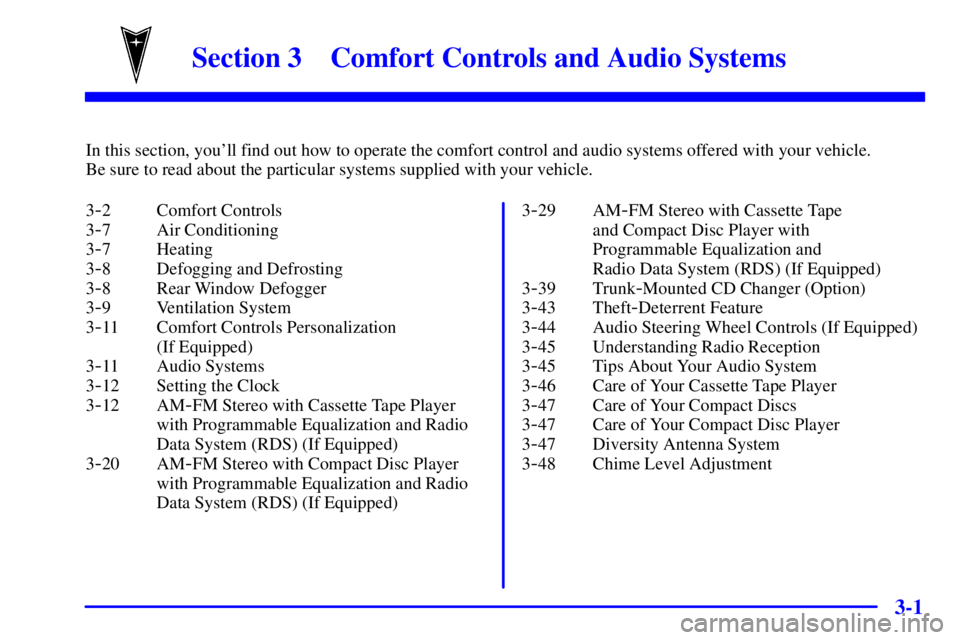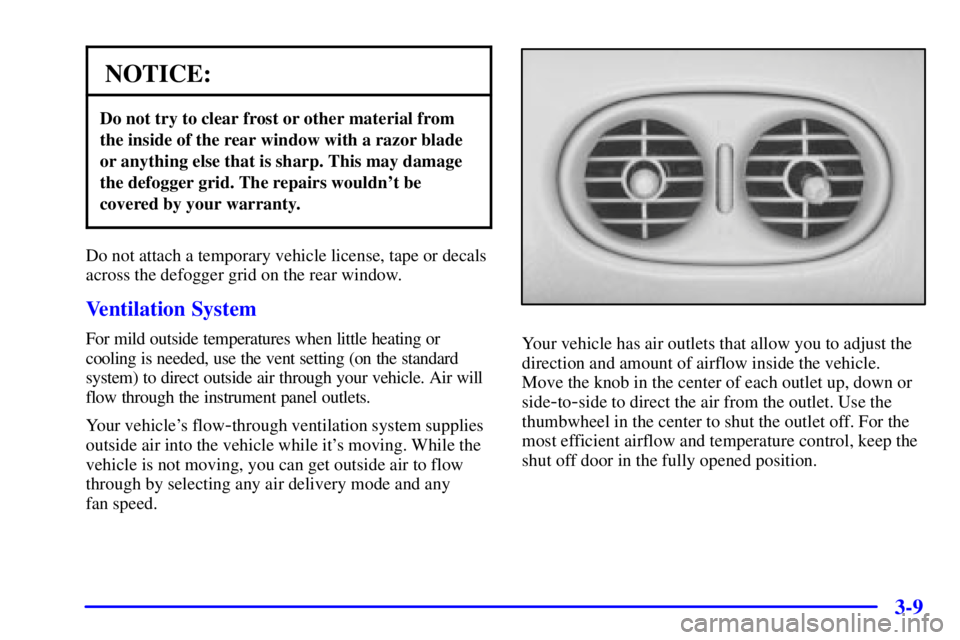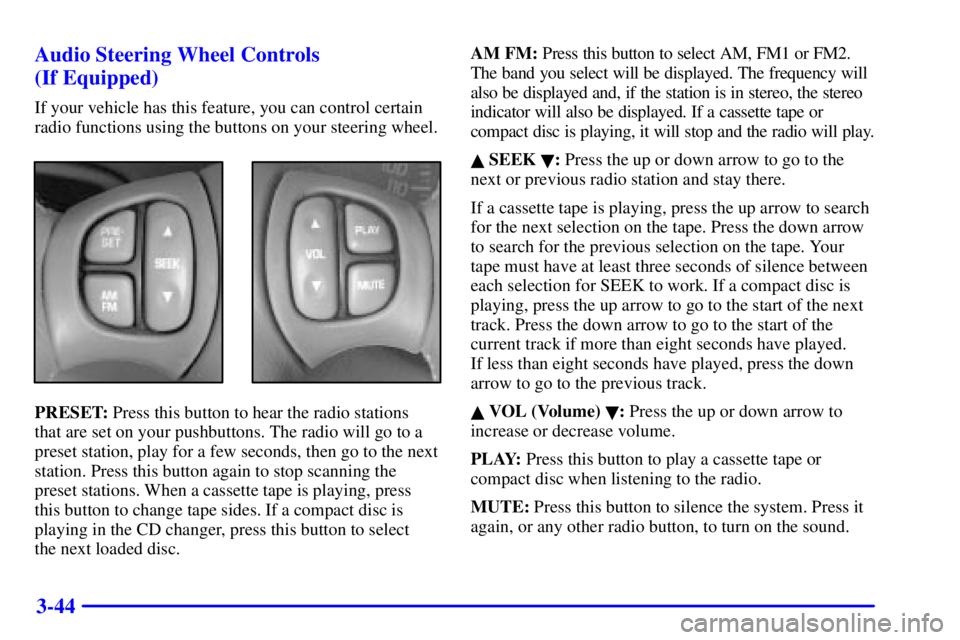Page 134 of 427
2-71
The main components of your instrument panel are the following:
A. Air Outlets
B. Turn Signal/Multifunction Lever
C. Audio System Steering Wheel Controls
(If Equipped)
D. Windshield Wiper Lever
E. Steering Column Shift Lever
F. Driver Information Center (DIC) Controls
(If Equipped)
G. Audio SystemH. Hazard Warning Flashers Control
I. Twilight Sentinel
� Controls and Fog Lamps Button
J. Ignition Switch
K. Comfort Control System
L. Heated Seat Switches (Option)
M. Traction Control Button (If Equipped)
N. Cigarette Lighter
O. Glove Box
Page 145 of 427

2-82
Traction Control System Warning
Light (Option)
This warning light should
come on briefly when the
engine is started.
If the warning light doesn't come on then, have it fixed
so it will be ready to warn you if there's a problem. If it
stays on, or comes on when you're driving, there may be
a problem with your traction control system and your
vehicle may need service. When this warning light is
on, the system will not limit wheel spin. Adjust your
driving accordingly.The traction control system warning light may come on
for the following reasons:
�If you turn the system off by pressing the
TRACTION CONTROL button located on the
center console, the warning light will come on and
stay on. To turn the system back on, press the
button again. The warning light should go off.
See ªTraction Control Systemº in the Index for
more information.
�If there's a brake system problem that is specifically
related to traction control, the traction control system
will turn off and the warning light will come on. If
your brakes begin to overheat, the traction control
system will turn off and the warning light will come
on until your brakes cool down.
�If the traction control system is affected by an
engine
-related problem, the system will turn off and
the warning light will come on.
If the traction control system warning light comes on
and stays on for an extended period of time when the
system is turned on, your vehicle needs service.
Page 146 of 427

2-83 Low Traction Active (LOW TRAC) Light
Your LOW TRAC (Low
Traction Active) light may
come on for one of the
following reasons:
�An advanced computer
-controlled system called
Stabilitrak� (if equipped) has come on to help your
vehicle continue to go in the direction in which
you're steering. This stability enhancement system
activates when the computer senses that your vehicle
is just starting to spin, as it might if you hit a patch
of ice or other slippery spot on the road. When the
system is on, you may hear a noise or feel a vibration
in the brake pedal. This is normal.In these situations when the LOW TRAC light is on
and the system is engaged, you should continue to
steer in the direction you want to go. The system is
designed to help you in bad weather or other difficult
driving situations by making the most of whatever
road conditions will permit.
�The optional Traction Control System is active and is
limiting wheel spin. You may feel the system
working, but this is normal. Slippery road conditions
may exist, so adjust your driving accordingly.
If the LOW TRAC light comes on, slippery road
conditions may exist, so you should consider slowing
down and adjusting your driving accordingly.
Page 175 of 427

3-
3-1
Section 3 Comfort Controls and Audio Systems
In this section, you'll find out how to operate the comfort control and audio systems offered with your vehicle.
Be sure to read about the particular systems supplied with your vehicle.
3
-2 Comfort Controls
3
-7 Air Conditioning
3
-7 Heating
3
-8 Defogging and Defrosting
3
-8 Rear Window Defogger
3
-9 Ventilation System
3
-11 Comfort Controls Personalization
(If Equipped)
3
-11 Audio Systems
3
-12 Setting the Clock
3
-12 AM-FM Stereo with Cassette Tape Player
with Programmable Equalization and Radio
Data System (RDS) (If Equipped)
3
-20 AM-FM Stereo with Compact Disc Player
with Programmable Equalization and Radio
Data System (RDS) (If Equipped)3
-29 AM-FM Stereo with Cassette Tape
and Compact Disc Player with
Programmable Equalization and
Radio Data System (RDS) (If Equipped)
3
-39 Trunk-Mounted CD Changer (Option)
3
-43 Theft-Deterrent Feature
3
-44 Audio Steering Wheel Controls (If Equipped)
3
-45 Understanding Radio Reception
3
-45 Tips About Your Audio System
3
-46 Care of Your Cassette Tape Player
3
-47 Care of Your Compact Discs
3
-47 Care of Your Compact Disc Player
3
-47 Diversity Antenna System
3
-48 Chime Level Adjustment
Page 183 of 427

3-9
NOTICE:
Do not try to clear frost or other material from
the inside of the rear window with a razor blade
or anything else that is sharp. This may damage
the defogger grid. The repairs wouldn't be
covered by your warranty.
Do not attach a temporary vehicle license, tape or decals
across the defogger grid on the rear window.
Ventilation System
For mild outside temperatures when little heating or
cooling is needed, use the vent setting (on the standard
system) to direct outside air through your vehicle. Air will
flow through the instrument panel outlets.
Your vehicle's flow
-through ventilation system supplies
outside air into the vehicle while it's moving. While the
vehicle is not moving, you can get outside air to flow
through by selecting any air delivery mode and any
fan speed.
Your vehicle has air outlets that allow you to adjust the
direction and amount of airflow inside the vehicle.
Move the knob in the center of each outlet up, down or
side
-to-side to direct the air from the outlet. Use the
thumbwheel in the center to shut the outlet off. For the
most efficient airflow and temperature control, keep the
shut off door in the fully opened position.
Page 218 of 427

3-44 Audio Steering Wheel Controls
(If Equipped)
If your vehicle has this feature, you can control certain
radio functions using the buttons on your steering wheel.
PRESET: Press this button to hear the radio stations
that are set on your pushbuttons. The radio will go to a
preset station, play for a few seconds, then go to the next
station. Press this button again to stop scanning the
preset stations. When a cassette tape is playing, press
this button to change tape sides. If a compact disc is
playing in the CD changer, press this button to select
the next loaded disc.AM FM: Press this button to select AM, FM1 or FM2.
The band you select will be displayed. The frequency will
also be displayed and, if the station is in stereo, the stereo
indicator will also be displayed. If a cassette tape or
compact disc is playing, it will stop and the radio will play.
� SEEK �: Press the up or down arrow to go to the
next or previous radio station and stay there.
If a cassette tape is playing, press the up arrow to search
for the next selection on the tape. Press the down arrow
to search for the previous selection on the tape. Your
tape must have at least three seconds of silence between
each selection for SEEK to work. If a compact disc is
playing, press the up arrow to go to the start of the next
track. Press the down arrow to go to the start of the
current track if more than eight seconds have played.
If less than eight seconds have played, press the down
arrow to go to the previous track.
� VOL (Volume) �: Press the up or down arrow to
increase or decrease volume.
PLAY: Press this button to play a cassette tape or
compact disc when listening to the radio.
MUTE: Press this button to silence the system. Press it
again, or any other radio button, to turn on the sound.
Page 230 of 427
4-8
Let's say the road is wet and you're driving safely.
Suddenly, an animal jumps out in front of you. You slam
on the brakes and continue braking. Here's what
happens with ABS:
A computer senses that wheels are slowing down. If one
of the wheels is about to stop rolling, the computer will
separately work the brakes at each front wheel and at
both rear wheels.The anti
-lock system can change the brake pressure
faster than any driver could. The computer is
programmed to make the most of available tire and road
conditions. This can help you steer around the obstacle
while braking hard.
As you brake, your computer keeps receiving updates on
wheel speed and controls braking pressure accordingly.
Page 231 of 427

4-9
Remember: Anti-lock doesn't change the time you need
to get your foot up to the brake pedal or always decrease
stopping distance. If you get too close to the vehicle in
front of you, you won't have time to apply your brakes
if that vehicle suddenly slows or stops. Always leave
enough room up ahead to stop, even though you have
anti
-lock brakes.
Using Anti
-Lock
Don't pump the brakes. Just hold the brake pedal down
firmly and let anti
-lock work for you. You may feel a
slight brake pedal pulsation or notice some noise, but
this is normal.
Braking in Emergencies
With anti-lock, you can steer and brake at the same
time. In many emergencies, steering can help you more
than even the very best braking.
Traction Control System
(If Equipped)
Your vehicle may have a traction control system that
limits wheel spin. This is especially useful in slippery
road conditions. The system operates only if it senses
that one or both of the front wheels are spinning or
beginning to lose traction. When this happens, the
system works the front brakes and reduces engine power
to limit wheel spin.
You may feel or hear the system working, but this
is normal.
If your vehicle is in cruise control when the traction
control system begins to limit wheel spin, the cruise
control will automatically disengage. When road
conditions allow you to safely use it again, you may
reengage the cruise control. See ªCruise Controlº in
the Index.
This light should come on
briefly when you start the
engine. If it stays on or
comes on while you are
driving, there's a problem
with your traction
control system.